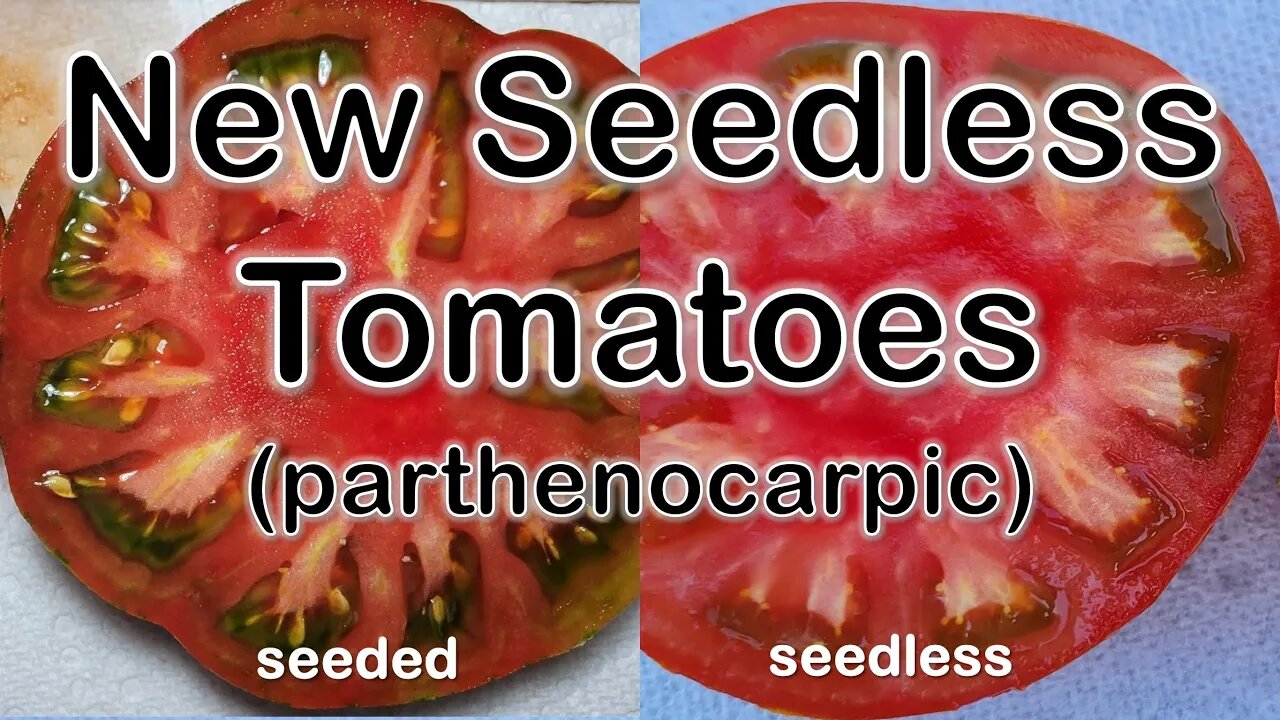Premium Only Content

Seedless Tomato Miracle & The Magic of Parthenocarpy
#seedless #parthenogenesis #seedlesstomato
To understand my work, you gotta understand the reason it's important. This video attempts to explain parthenocarpy. It gives common foods we eat that are parthenocarpic, seedless, and then goes on to explain the positives and perceived negatives. Below, you will find many scientific articles on parthenocarpy by scientists from all over the world. As I always suggest, do your own research and form your own opinions.
My cultivars will have "bear" as part of the name. It's a reference to the improved ability to set fruit or bear fruit. It's not about the animal! The simple takeaway is that my lines do not need bees to pollinate them. There's no need for pollination so the production of fruit is no longer limited by hot weather, colder weather, and highly humid conditions. They'll grow in Florida, the US South, and even in Alaska.
Many nations all over the world have been trying to "find" and breed the magic perfect parthenocarpic tomato lines since the early 20th century. Yep, been so many decades of searching and still till this day! Read for yourself and come to your own conclusions. More to come.
#SeedlessTomato #ParthenocarpicTomato #Parthenocarpy
CONTACT INFO. If you have questions, or just want to chat about anything, you can contact me at c3voyage@gmail.com. You can also leave a comment in the video. I won't hide anything. There is no deception going on.
Links to a few scientific articles on the pursuit of parthenocarpy in tomato. They explain a lot of background and importance of it:
1. Understanding Tomato Fruit Set | University of Missouri, published by Division of Plant Sciences, 52 Agriculture Lab, Columbia, MO
April 2013
https://ipm.missouri.edu/MPG/2013/4/Understanding-Tomato-Fruit-Set/?fbclid=IwAR2OV1wjdfQw5pPjytan2r8G8jYtMG7Xkol-E8TStE3HXNJmNWVzE209Pxk
2. The Occurrence of Seedlessness in Higher Plants; Insights on Roles and Mechanisms of Parthenocarpy | Maurizio E. Picarella and Andrea Mazzucato
January 2019
https://www.frontiersin.org/articles/10.3389/fpls.2018.01997/full
3. How Hormones and MADS-Box Transcription Factors Are Involved in Controlling Fruit Set and Parthenocarpy in Tomato | Barbara Molesini, Valentina Dusi, Federica Pennisi, and Tiziana Pandolfini
October 2020
https://www.mdpi.com/2073-4425/11/12/1441
4. The parthenocarpic gene Pat-k is generated by a natural mutation of SlAGL6 affecting fruit development in tomato (Solanum lycopersicum L.) | Rihito Takisawa, Tetsuya Nakazaki, Tsukasa Nunome, Hiroyuki Fukuoka, Keiko Kataoka, Hiroki Saito, Tsuyoshi Habu & Akira Kitajima
April 2018
https://bmcplantbiol.biomedcentral.com/articles/10.1186/s12870-018-1285-6#article-info
5. SlTPL1 Silencing Induces Facultative Parthenocarpy in Tomato | Mi He, Shiwei Song, Xiaoyang Zhu, Yuxiang Lin, Zanlin Pan, Lin Chen, Da Chen, Guojian Hu, Baowen Huang, Mengyi Chen, Caiyu Wu, Riyuan Chen, Mondher Bouzayen, Mohammed Zouine and Yanwei Hao
May 2021
https://www.frontiersin.org/articles/10.3389/fpls.2021.672232/full?fbclid=IwAR1cteb7H5O4MC741qIfNOd1_CzxfD2KJgQwheAyMKPWDuluYZHEFIHpV8w
6. Parthenocarpy in the Tomato (Solanum lycopersicum L.) Cultivar ‘MPK-1’ is Controlled by a Novel Parthenocarpic Gene | Rihito Takisawa, Takayuki Maruyama, Tetsuya Nakazaki, Keiko Kataoka, Hiroki Saito, Sota Koeda, Tsukasa Nunome, Hiroyuki Fukuoka, Akira Kitajima
January 2017
https://www.jstage.jst.go.jp/article/hortj/86/4/86_OKD-042/_html/-char/en
7. Rapid breeding of parthenocarpic tomato plants using CRISPR/Cas9 | Risa Ueta, Chihiro Abe, Takahito Watanabe, Shigeo S. Sugano, Ryosuke Ishihara, Hiroshi Ezura, Yuriko Osakabe & Keishi Osakabe
March 2017
https://www.nature.com/articles/s41598-017-00501-4
8. Tomato facultative parthenocarpy results from SlAGAMOUS‐LIKE 6 loss of function | Chen Klap, Ester Yeshayahou, Anthony M. Bolger, Tzahi Arazi, Suresh K. Gupta, Sara Shabtai, Björn Usadel, Yehiam Salts, and Rivka Barg
December 2016
https://www.ncbi.nlm.nih.gov/pmc/articles/PMC5399002/
9. **The inheritance of parthenocarpy in tomato (Lycopersicon esculentum) | Thesis by Deborah Kean of Oregon State University
April 1983
https://ir.library.oregonstate.edu/concern/graduate_thesis_or_dissertations/q811kp22m?locale=en (click the download PDF) link to view full thesis.
** Of importance as it was approved by James R. Baggett, the originator and breeder of all of OSU's parthenocarpic public lines today. It's true insight into their breeding thoughts and the only circulated parthenocarpic varieties out there of pat-2.
NOTE: This list goes on and on, but there's only 5000 characters available in the description here. These 9 should be enough to get interested parties going. Most of the articles on the matter aren't fully public and require special access or payment for the article.
-
 28:39
28:39
The Why Files
3 days agoCryptids Vol. 4 | Bunyips, Yowie and Australian Nightmare Fuel
18.2K35 -
 1:07:06
1:07:06
Mike Rowe
18 days agoThe Fight For America's Heartland | Salena Zito #442 | The Way I Heard It
14.6K44 -
 LIVE
LIVE
TimcastIRL
2 hours agoSouth Park Goes FULL CHARLIE KIRK, Latest Episode ROASTS Trump Again | Timcast IRL
8,375 watching -
 LIVE
LIVE
SpartakusLIVE
3 hours agoThe Return of the KING of Content
517 watching -
 10:05
10:05
MattMorseTV
6 hours ago $2.11 earnedHe actually did it...
14K12 -
 LIVE
LIVE
Anthony Rogers
1 day agoEpisode 376 - Todd Schowalter
69 watching -
 LIVE
LIVE
megimu32
2 hours agoOTS: Movie Tie-In Games + Remakes: Let’s Play Memory Lane
118 watching -
 LIVE
LIVE
Adam Does Movies
9 hours agoTalking Movies + Ask Me Anything - LIVE
72 watching -
 1:17:18
1:17:18
Glenn Greenwald
1 day agoWhat are CBS News' Billionaire Heirs Doing with Bari Weiss? With Ryan Grim on the Funding Behind It; Europe Capitulates to Trump Again | SYSTEM UPDATE #494
94.4K63 -
 1:43:49
1:43:49
RiftTV
4 hours agoCNN Calls Black NY Shooter WHITE, Cincinnati FATIGUE | The Rift | Guest: Braeden Sorbo, 2Protects1
37K13